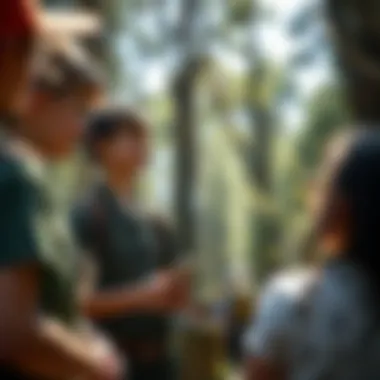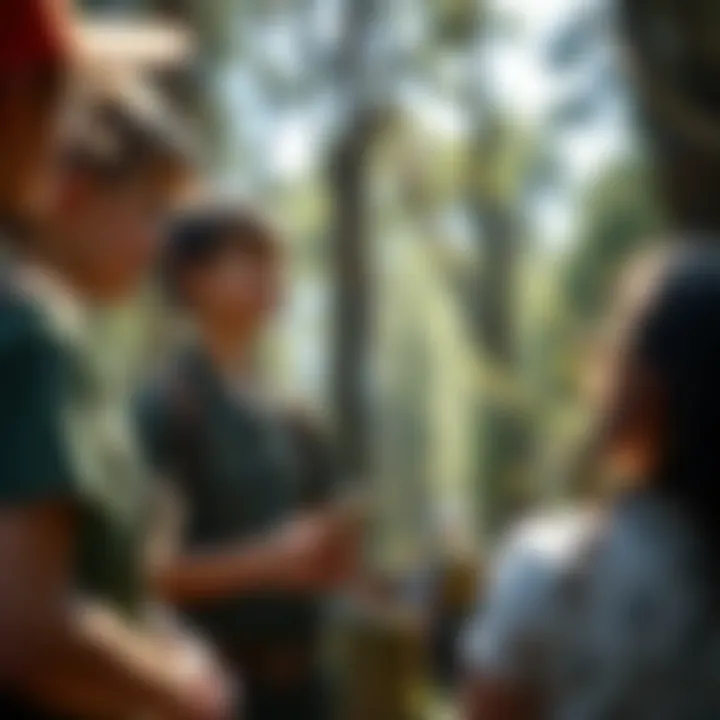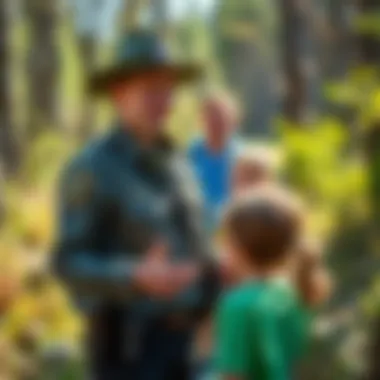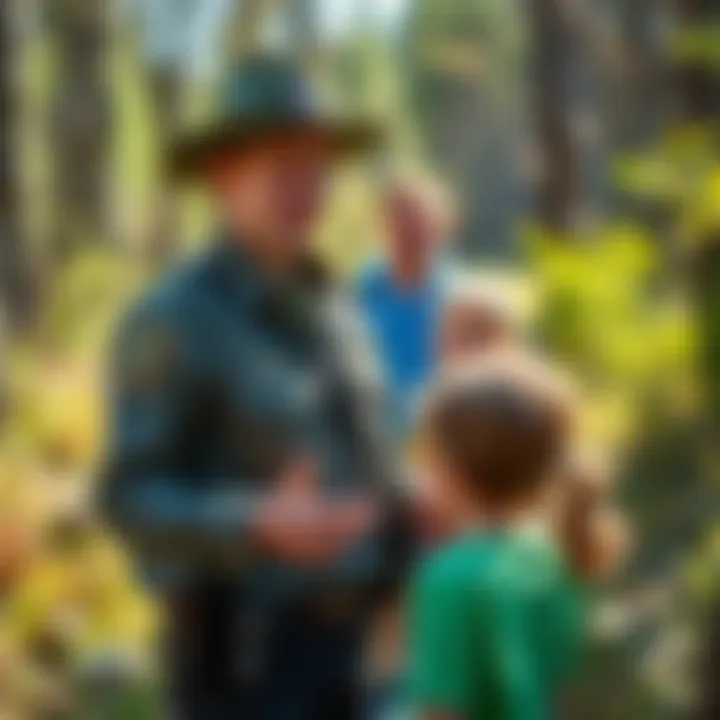Exploring the Junior Ranger Badge Program in Depth


Intro
The connection between youth and the natural world has gained paramount importance in today's society, especially within the realm of environmental education. Fostering that bond begins with early engagement—enter the Junior Ranger Badge program. This initiative not only highlights the beauty and complexity of our national parks but also invites young people to learn about environmental stewardship through hands-on experiences.
The badge serves as a gateway for children to explore their surroundings with a sense of responsibility. Through the Junior Ranger program, they delve into various activities, immersing themselves in the wonders of nature while gaining critical knowledge about conservation.
In this article, we will examine the significance, logistics, and core components of the Junior Ranger Badge, emphasizing its role in not just individual development but also in nurturing a generation that understands the value of our planet's resources.
Overview of Forestry Practices
Understanding forestry practices is essential for grasping the principles behind the Junior Ranger Badge program, as it sheds light on the broader environmental context.
Importance of Foresting
Forests are the lungs of our planet, absorbing carbon dioxide and releasing oxygen. They also provide habitats for numerous species, contribute to watershed health, and support local economies through recreation and resource management. The importance of fostering a sustainable relationship between youths and forests cannot be understated, as it lays the groundwork for responsible future stewards.
Types of Forestry Practices
There are several critical practices in forestry that spur effective woodland management. Some of these include:
- Selective Logging: Taking only some trees while leaving others intact helps maintain forest structure and biodiversity.
- Reforestation: Planting trees in deforested areas ensures that biodiversity is restored and habitat is provided for wildlife.
- Thinning: This process reduces competition among trees, leading to healthier, more robust forest growth.
These forestry practices align with the objectives of the Junior Ranger program by educating participants on sustainable methodologies, thereby instilling a sense of responsibility toward forest conservation in the young minds engaged.
Best Practices for Sustainable Woodland Stewardship
Incorporating sustainability into forestry interlinks with the ethos of the Junior Ranger initiative. To make the program effective, understanding best practices becomes crucial.
Principles of Sustainable Forestry
Sustainable forestry is grounded in several guiding principles:
- Ecosystem Balance: Keeping the ecological equilibrium ensures that any forestry action harmonizes with natural processes.
- Community Engagement: Empowering local communities to partake in forestry decisions fosters a sense of ownership and stewardship.
- Long-term Planning: Sustainable techniques require foresight, balancing immediate needs with future consequences ensures forests remain viable for generations.
Techniques for Land Management
Effective land management supports sustainable forestry practices. A few techniques include:
- Controlled Burns: Used to reduce forest floor debris, preventing larger and uncontrolled wildfires.
- Agroforestry: Combining agriculture and forestry practices creates symbiotic relationships that yield both timber and agricultural products.
- Preventative Maintenance: Regular assessments and monitoring prevent detrimental issues before they escalate, safeguarding the integrity of the ecosystem.
Innovative Techniques in Forestry
Innovation is at the heart of progressing forestry practices, and it significantly aligns with how the Junior Ranger program enriches participants' skills and perspectives.
Latest Technological Advancements
The forestry industry is witnessing groundbreaking developments that enhance our understanding and management of woodlands. Technologies such as GIS (Geographic Information Systems) and drones facilitate precise mapping, while remote sensing aids in monitoring forest health sustainably and effectively.
Integrating Traditional Knowledge with Modern Science
Combining age-old practices from indigenous cultures with contemporary scientific methods has driven many successful conservation efforts. Harnessing this knowledge not only respects historical ties to the land but also employs proven strategies that can lead to improved outcomes for environmental health.
With strong roots in local cultures and modern science, sustainable forestry fosters a more resilient future for our woodlands.
For additional information, consider checking resources on forestry practices available at:
Prelude to the Junior Ranger Badge
The Junior Ranger Badge is more than just a shiny emblem; it serves as a gateway for youth to connect with the natural world. This initiative encourages children to immerse themselves in their surroundings, promoting a healthy curiosity about nature and environmental stewardship. As young people engage with the different ecosystems in national parks, they aren't merely participating in recreational activities. They're learning pivotal lessons on conservation, responsibility, and the importance of preserving our planet for future generations.
Definition and Purpose
The Junior Ranger program is primarily designed to foster a sense of environmental awareness among children. It invites them to become stewards of the land, engaging in various activities that both educate and inspire. Children who earn the badge often participate in interpretive programs, guided hikes, and other educational experiences tailored to instill a deeper understanding of their natural heritage. The badge symbolizes their commitment to protecting and enjoying the natural environment.
It’s crucial to note that the program isn’t merely about rewarding participation. The emphasis is on the learning experience; children must complete specific assignments and engage in hands-on activities that require thought and planning. This process not only enhances their skill set but also builds confidence, making them feel like active participants in something greater than themselves. Being a Junior Ranger encourages the young folk to understand their roles in larger ecological networks, thus paving the way for more informed future citizens.
Historical Context


The origins of the Junior Ranger program can be traced back to the late 1960s, when national parks began to recognize the need to engage young visitors. Initially, the program aimed to address a growing disconnect between children and the outdoors. As cities expanded and technology saturated daily life, the rich experiences offered by nature started to fade from public consciousness.
In response, national parks developed structured activities for young visitors, allowing them an interactive way to learn about flora and fauna. The program has since evolved, expanding into various parks across the United States, with each adopting unique activities that reflect their local biodiversity and culture. By immersing themselves in the park's environment, children were able to spark a keen interest in conservation efforts, inspiring many to pursue future endeavors in environmental science or park management.
This grassroots initiative has grown over the years, now consisting of numerous local adaptations and outreach efforts that seek to include a diverse group of participants. Current trends emphasize inclusivity and accessibility, ensuring that all children have a chance to earn the badge, thus helping the symbols of nature resonate with wider audiences.
The Structure of the Program
The structure of the Junior Ranger Badge program serves as the framework that supports youth in their journey towards environmental stewardship. It is important not just for the logistics it provides but for the educational and experiential opportunities it opens up. The program's design ensures that young participants engage meaningfully with nature, allowing them to build knowledge and skills while instilling a sense of responsibility for the environment.
Eligibility and Enrollment
Eligibility for the Junior Ranger Badge program is designed to be inclusive, allowing children from various backgrounds to participate. Generally, this program is aimed at youth between the ages of four and eighteen. Enrolled participants often have the option to join through national parks or specific educational settings that support environmental learning.
Parents and guardians often play a pivotal role in enrolling their children, making it necessary to inform them of the criteria and process. Online registration is available at many national park websites, making it easier for families to sign up. This approach connects families directly with local park resources, emphasizing community engagement and knowledge sharing.
Badge Requirements
The journey to earning a Junior Ranger Badge involves fulfilling several key requirements that help develop a well-rounded understanding of environmental stewardship. These can include engaging in activities, passing knowledge tests, and completing hands-on projects.
Activity Completion
Activity completion is a cornerstone of the Junior Ranger program. Participants engage in guided activities that may include ranger-led tours or nature walks, fostering a direct connection with the park’s environment. This hands-on approach is beneficial because it engages various learning styles, enabling children to grasp concepts through experience rather than solely theoretical knowledge.
One unique feature of activity completion is its flexibility. Each park offers customized activities tailored to its local environment, appealing to the interests of the participants. However, the downside can be variability; some parks may offer more robust programs than others, affecting a consistent experience across regions.
Knowledge Tests
Knowledge tests contribute specifically to verifying what participants have learned through their engagement with educational materials and experiences. These tests often include simple quizzes tailored to the age groups, which can be both fun and educational.
The key characteristic of these tests is their ability to provide immediate feedback. This feedback helps young learners understand where they excel and where additional learning may be needed. A disadvantage, however, is that the focus on testing may deter some children who might find it intimidating. Balancing encouragement with assessment is essential for maximizing benefits.
Hands-On Projects
Hands-on projects offer an immersive aspect to the program, allowing participants to create or build something tangible that relates to their learning. This could be anything from constructing birdhouses to conducting water quality tests in local streams. The process of working on these projects significantly enhances critical thinking and problem-solving skills, crucial for future environmental leaders.
The distinctive feature of hands-on projects lies in their collaborative nature; they often involve teamwork, which helps build social skills among participants. However, these projects can have logistical challenges. Not all parks may have the resources or facilities to support certain types of projects, which can limit options for some participants.
"Hands-On learning is not just a buzzword; it’s about making connections with the world around us, which sticks with kids for life."
Activities Associated with Earning the Badge
Earning the Junior Ranger Badge involves a variety of activities designed to engage youth and deepen their connection with nature. The importance of these activities cannot be overstated; they not only ignite curiosity about the environment but also establish a foundational sense of responsibility towards it. The mere act of engaging in hands-on learning experiences fosters a passion for stewardship and conservation, which can last a lifetime.
Educational Programs
Educational programs stand at the forefront of the Junior Ranger experience. Typically conducted in parks and nature centers, these programs aim to enlighten young participants about crucial environmental topics, such as biodiversity, habitats, and conservation efforts. The targeted approach often uses interactive sessions, workshops, and guided tours that make complex concepts accessible.
For example, imagine children learning about the life cycle of a butterfly through a vivid presentation followed by a field excursion to observe these insects in their natural habitat. Experiences like these can spark a lifelong interest in biology and ecology. Furthermore, such educational initiatives help dispel misinformation about our ecosystems, creating informed future citizens who can advocate for environmental health.
"Education is not preparation for life; education is life itself." – John Dewey
Outdoor Explorations
Nothing beats the thrill of outdoor exploration. Activities such as hiking, camping, and nature walks are not just fun; they are vital in teaching participants about ecology and conservation practices firsthand. During these excursions, youths can witness the delicate balance of ecosystems and the interdependence of species.
Through outdoor explorations, participants engage with the environment in meaningful ways. They might identify plant species, track animal signs, or even measure the health of their local stream's ecosystem. Each exploration hammers home the idea that every individual can play a key role in protecting the planet. Moreover, these experiences promote physical health and well-being, encouraging young people to enjoy and value nature as a fundamental aspect of their lives.
Community Service Projects
Community service projects are another crucial element of earning the Junior Ranger Badge. These projects often involve activities such as park clean-ups, tree planting, or assisting wildlife rehabilitation efforts. By participating in these initiatives, kids can see the tangible impacts of their actions on local environments—an empowering realization.
Engagement in community service allows participants to learn about the challenges facing their local ecosystems while fostering a sense of camaraderie with peers. They not only develop practical skills, such as teamwork and project management, but also gain an understanding of the civic responsibilities that come with living in a community.
Impacts on Youth Engagement
Engaging youth in environmental education is a pivotal element of the Junior Ranger Badge program. Through this initiative, younger generations not only learn about but also connect deeply with their natural surroundings. The impacts on youth engagement are multifaceted, offering a blend of educational, emotional, and practical benefits that resonate well beyond the immediate activities.
Building Environmental Awareness
One of the hallmark benefits of the Junior Ranger Badge program is its capacity to instill a genuine understanding of environmental principles in youth. As these young participants delve into the intricacies of nature, they become increasingly adept at recognizing the significance of ecosystem balance.


- Observation Skills: Children are taught to observe wildlife, plants, and geographical features. This hands-on approach makes lessons more tangible; it’s easier to grasp concepts like biodiversity when you see local species in their natural habitats.
- Impact of Human Activity: By learning about the effects of pollution, deforestation, and other human activities, youth begin to understand not only what is at stake but also their role in fostering change. Discussions might lead to realizations about the significance of recycling, reducing waste, and participating in conservation efforts.
- Connection with Nature: During outdoor explorations, children are encouraged to interact with their surroundings. Whether it’s identifying a tree species or understanding the water cycle, this engagement fosters a long-lasting appreciation for the environment.
An investment in youth engagement now ensures a generation that values and strives to protect our natural world.
Fostering a Sense of Responsibility
Moreover, the Junior Ranger Badge program plays a crucial role in fostering responsibility among its young participants. When children commit to activities aimed at earning their badge, they are not only embarking on a path of personal growth, but they also learn to respect their role within the ecosystem.
- Personal Accountability: Completing badge requirements, such as knowledge tests and community service projects, encourages children to take responsibility for their learning outcomes. This breeds a sense of ownership; they realize their actions matter.
- Teamwork and Cooperation: Often, activities require collaboration with peers or family members. This cooperation not only strengthens social skills but also teaches the importance of working together toward common goals, much like the collective effort needed for community conservation projects.
- Legacy of Involvement: By fostering environmental stewardship at an early age, children are more likely to carry these values into adulthood. They become proactive members of society who not just engage with environmental concerns but contribute positively to solutions.
In summary, the Junior Ranger Badge program serves as a robust platform for enriching youth engagement. Through building environmental awareness and fostering a sense of responsibility, it equips children with the knowledge and skills necessary to navigate and advocate for a sustainable future. As communities invest in these programs, they are investing in a healthier planet and a more informed populace.
Challenges and Considerations
When exploring the Junior Ranger Badge, one must consider various components that can significantly affect the program's overall effectiveness and accessibility. These challenges can impact both the youth participating and the educators and mentors guiding their journey. Addressing these considerations is vital for ensuring the program’s objectives are fully realized and its benefits extended to as many young minds as possible.
Accessibility of Programs
Accessibility plays a pivotal role in the Junior Ranger initiative. It refers not only to physical access to national parks but also to socio-economic factors that may inhibit participation. National parks often reside in remote areas, presenting travel challenges for families who might not have easy means of transportation. To mitigate this, many parks are focused on creating partnerships with local communities and schools to facilitate youth engagement.
Moreover, materials and programs need to accommodate different learning styles and abilities. For instance, some children might find navigating a printed workbook a hurdle, while others may prefer digital formats or hands-on activities. Therefore, it’s crucial for park programs to offer various approaches to learning, ensuring inclusivity for all participants.
Additionally, financial barriers can prohibit certain families from engaging in park activities. Some parks have instituted fee waivers or provided free access to programs as a means of leveling the playing field. This helps break down the barriers some families face in accessing these valuable resources, bringing nature and education to a wider audience.
"Breaking down barriers to education not only changes individual lives but can ripple through communities, inspiring collective growth and awareness."
Balancing Structure with Freedom
Finding the right mix of structure and freedom in the Junior Ranger program is a delicate dance. A rigid framework can stifle creativity in young minds, while a lack of guidance may leave them feeling lost. Therefore, educators play a critical role in balancing these elements.
A structured environment provides clarity regarding expectations, helping children understand what is required to earn their badges. This structure might include specific activities, timelines, and educational objectives. However, it is equally important to weave in elements of freedom where kids can explore their interests. Allowing them to choose certain activities or projects can foster a deeper connection to nature and the environment.
For instance, while the program sets mandatory educational milestones, providing flexibility within those milestones can encourage individuality. One child may gravitate toward wildlife photography, while another might explore ecological science through planting trees. This type of freedom can enhance engagement and make the learning experience richer and more personal.
Furthermore, it is essential that both educators and parents recognize the importance of this balance. While educators shape the program’s framework, parents can enable explorative discussions at home. Encouraging kids to share their discoveries and thoughts reinforces the sense of ownership over their education, aligning perfectly with the ethos of the Junior Ranger initiative.
Role of Educators and Mentors
When it comes to programs like the Junior Ranger Badge, the pivotal role of educators and mentors can't be overstated. These individuals serve as the backbone of the initiative, providing guidance, enthusiasm, and structure to young participants. Their involvement not only enhances the educational experience but also instills a sense of purpose in each child. Mentors help bridge the gap between the written requirements of the Junior Ranger program and the real-world application of those principles.
Guiding Participation
Mentors are instrumental in guiding youth through the various activities needed to earn their Junior Ranger Badge. They encourage students to engage with different educational programs, outdoor explorations, and community service projects. When a mentor is present, it becomes easier for children to tap into their curiosity about the environment. Instead of just checking boxes, mentors push youngsters to ask questions, explore deeper, and foster genuine interest in nature.
For example, during nature hikes, a knowledgeable educator can point out various plant species or animal tracks, transforming a simple walk into an interactive learning opportunity. This kind of engagement doesn’t just fill in a checklist; it builds lasting memories and a real appreciation for the natural world.
Furthermore, mentors can also tailor activities to match the skill levels and interests of each child, making participation accessible and enjoyable. This personalized attention helps nurture confidence, as each child feels understood and appreciated. It’s like having a coach in your corner who knows exactly what you need to succeed.
Integrating Badge Activities into Curriculum
Integrating the Junior Ranger activities into school curriculums offers another layer of complexity—and richness—to the learning experience. Educators can seamlessly weave these activities into subjects like science, geography, or even art. This interdisciplinary approach not only emphasizes the relevance of environmental education but also broadens the scope of learning beyond traditional classroom walls.
Consider this: a teacher might have students create a project based on local ecosystems as part of their science curriculum. This project could involve researching local species, identifying their roles within their habitat, and even constructing a presentation, mirroring the objectives of the Junior Ranger program.
By aligning these activities with learning outcomes, educators help students see the direct correlation between academic achievement and environmental stewardship. It fosters an environment where children learn not only to be thinkers but also doers—active participants in their communities.
The collaboration between educators, mentors, and the Junior Ranger program underscores the importance of community in nurturing the next generation of conservationists.
"The best way to find yourself is to lose yourself in the service of others." – Mahatma Gandhi
Parent Involvement
Parent involvement in the Junior Ranger Badge program is crucial for maximizing the educational potential and fostering a deep-seated appreciation for nature within children. Parents serve as the primary support system for children participating in this engaging initiative. The active engagement of parents doesn't merely lend a helping hand; it lays the groundwork for a more enriching experience, blossoming curiosity and thoughtfulness toward the environment.
Supporting Participation at Home
To ensure kids reap the full benefits of the Junior Ranger Badge, parents can embrace several strategies. One effective approach is to create a conducive environment for learning at home. Parents can encourage discussions about the topics their children explore in their activities. For instance, if a child completes an assignment about local flora and fauna, parents can take it further by planning a nature walk nearby. This not only cements the knowledge gained but also nurtures a connection with the environment.
Here are a few methods parents can implement:
- Regular Discussions: Initiate conversations about experiences related to nature. Ask open-ended questions like, "What did you find interesting in today's program?"
- Help with Projects: Offer assistance with badge-related assignments. This could include researching conservation efforts or completing a project on recycling.
- Incorporate Resources: Use books or documentaries about wildlife or ecosystems to spark interest and expand knowledge beyond the badge's requirements.


The act of actively engaging children over these subjects not only helps reinforce their learning but also makes them feel that their pursuits are valued. When parents take an earnest interest, kids are more likely to share what they learn and stay motivated.
Encouraging Outdoor Activities
Encouraging outdoor activities is another critical aspect of boosting a child’s involvement in the Junior Ranger program. Spending time outside is beneficial for physical health and promotes mental well-being. However, these experiences often provide rich educational opportunities. Here are some ways parents can encourage outdoor exploration:
- Nature Scavenger Hunts: Help plan a scavenger hunt in the local park, incorporating items related to their Junior Ranger studies. This not only aids in learning but also adds an element of fun.
- Family Hikes: Organize family hikes that align with topics they’re learning about. Exploring diverse terrains can foster curiosity about different ecosystems.
- Volunteer Together: Participate in local environmental initiatives or tree-planting events as a family. Such actions reinforce the value of stewardship and the impact of conservation efforts.
As the saying goes, "It takes a village to raise a child," and this proverb rings particularly true in the context of environmental education. Parents who are engaged encourage children to take their conservation education seriously while proactively nurturing their inquisitive spirits.
The benefits of fostering a love for the outdoors and environmental stewardship in kids can't be overstated. They become not only informed participants in the Junior Ranger program but also develop a long-lasting bond with nature that can influence their choices and attitudes well into adulthood.
In summary, parent involvement is vital in maximizing opportunities within the Junior Ranger Badge program. Parents empower children through support at home and encourage outdoor activities, laying the groundwork for future generations dedicated to preserving our natural heritage.
Broader Implications for Forest Stewardship
The Junior Ranger Badge program transcends mere participation; it plays a pivotal role in shaping the future of forest stewardship. By engaging young participants in hands-on activities, this initiative fosters a profound sense of responsibility toward natural resources. Such engagement is not just beneficial for the youth; it is essential for the communities and ecosystems they inhabit. The program aligns perfectly with contemporary calls for sustainable practices and environmental education, thus amplifying its relevance.
Sustainable Practices Promotion
One of the key strengths of the Junior Ranger Badge program is its emphasis on sustainable practices. Participants are immersed in activities that highlight the importance of responsible resource management. For instance, through projects that involve tree planting or habitat restoration, children not only learn about the theoretical aspects of ecology but also see the tangible results of their efforts. This hands-on approach demystifies concepts such as biodiversity, soil health, and water conservation, turning them into personal experiences rather than abstract ideas.
Studies show that early exposure to sustainable practices can cultivate lifelong habits of environmental stewardship. Kids who engage with nature through the Junior Ranger program become advocates for sustainability. They share their newfound knowledge with family and friends, initiating conversations about conservation. Such grassroots outreach enriches community understanding of sustainability, creating a ripple effect that encourages broader participation in eco-friendly initiatives.
Connecting Youth with Conservation Goals
Moreover, the program connects youth directly with broader conservation goals. By involving them in activities like wildlife monitoring, invasive species removal, or even citizen science initiatives, the Junior Ranger Badge nurtures a genuine interest in conservation. These activities help participants recognize their role in the ecological web and the impact their actions can have beyond the immediate environment.
"Children often regard wildlife as distant and unrelated to their lives. The Junior Ranger program bridges that gap, transforming perceptions and fostering curiosity about the ecosystem around them."
When youth see the consequences of their efforts, such as improved park conditions or thriving wildlife, it instills a sense of accomplishment that is vital for fostering long-term commitment. The program encourages them to think critically about environmental issues, enabling them to understand the intersectionality of conservation work, policy-making, and community activism.
In summary, the Junior Ranger Badge program is not just about earning a badge to display. It's an avenue for engaging young minds in sustainable practices that promote environmental awareness and align them with larger conservation objectives. As they connect with nature, they contribute meaningfully to the stewardship of the forests, fostering a new generation of informed and active environmental guardians.
Relevant Resources:
- U.S. National Park Service Junior Ranger Program
- National Geographic Education
- Environmental Protection Agency Resources
- National Wildlife Federation’s Programs
- American Forest Foundation
Case Studies of Successful Programs
Understanding how the Junior Ranger Badge programs function in real-world environments sheds light on their effectiveness and impact. The case studies serve not just as mere examples, but also provide valuable insights into best practices, challenges overcome, and the myriad of ways these programs can foster a sense of environmental stewardship among today’s youth. Analyzing these case studies allows stakeholders, including educators and policymakers, to recognize successful strategies and adapt them for their own contexts.
Program Highlights
One notable case is the Junior Ranger program implemented at Yellowstone National Park. Here, participants engage in hands-on activities that cover a diverse range of topics, from geology to wildlife. The program intricately weaves local park history with ecological education, ensuring that young participants leave not only with a badge but also with a profound passion for conservation.
Another exemplary program can be found at Yosemite National Park. This program expands upon traditional badge requirements by incorporating digital storytelling. Kids document their experiences using video and photography, sharing them through social media channels. This modern twist not only fosters engagement but helps develop crucial skills in communication and technology use.
Highlights of successful programs include:
- Interactive Learning: Engaging activities such as scavenger hunts, guided nature walks, and workshops led by park professionals that invite exploration.
- Community Collaboration: Many parks partner with local schools and non-profits, thereby broadening the reach of their programs and providing varied perspectives on conservation.
- Feedback Integrations: Programs often adapt according to participant feedback, ensuring that they remain relevant and effective.
Feedback from Participants
Listening to the voices of young participants reveals the significance of the Junior Ranger Badge program in their developmental journey. Many report an increased awareness of environmental challenges and a desire to take action in their communities. For instance, a survey conducted among Junior Rangers in Everglades National Park demonstrated that over 80% felt a stronger connection to nature after completing the program.
Furthermore, children often express the joy of learning in an outdoor setting as a pivotal part of their experiences. One young participant noted, > "Going to the park was not just fun; it felt like I was a part of something bigger. I want to help save our parks."
This sentiment echoes across numerous programs. In Grand Canyon National Park, participants noted they learned practical skills like hiking safety and wildlife protection, skills they say they now utilize in daily life. The opportunity to engage in conservation activities beyond just the park’s borders instills values of responsibility and awareness.
Collectively, these feedback narratives illustrate that the Junior Ranger Badge does not merely signify achievement; it symbolizes a commitment to preserving and valuing one’s environment.
Such case studies reveal not only the successful methodologies of these programs but also emphasize the critical role they play in shaping a generation that values and understands stewardship. This knowledge is essential for those involved in furthering the mission of environmental education.
Epilogue and Future Directions
The Junior Ranger Badge program stands as a significant bridge connecting younger generations with the natural environment. Reflecting on the multifaceted benefits of this initiative affords us a glimpse into the essential role it occupies in fostering a sense of stewardship among youth. Engaging children and teens in outdoor activities not only enriches their understanding of the ecosystem but also instills a lifelong appreciation for nature. This badge isn’t merely a token; it's a statement about valuing conservation and sustainability. It equips young people with the knowledge and skills needed to advocate for their environment, shaping future leaders in ecological responsibility.
A prevalent benefit of this program is the enhancement of environmental literacy, engaging participants in a hands-on approach to learning. Through various activities and requirements, children acquire a wealth of knowledge about local flora and fauna, ecosystem roles, and conservation efforts. These experiences cultivate a foundational respect for wildlife, inspiring them to become informed advocates for environmental issues. Additionally, the bonding experiences that often accompany such activities deepen family connections, which is vital for promoting a community-based approach to environmental stewardship.
"Youth participation in nature-based programs creates a ripple effect, influencing not just individuals but entire communities toward collective action for environmental conservation."
Looking toward the horizon, several key recommendations can bolster the effectiveness of the Junior Ranger program. Two areas warrant attention: expanding accessibility and integrating technology into program delivery. Accessibility is crucial; programs must reach children from diverse backgrounds and abilities. Consideration of transportation options, local outreach efforts, and tailored activities for special needs participants can broaden the program’s reach.
Incorporating technology could also enhance learning experiences. For example, offering mobile apps that allow for tracking the completion of activities or providing virtual tours of national parks can engage tech-savvy youths in a different manner. Interactive platforms for sharing experiences can create online communities where children and parents exchange ideas and foster a network of conservationists.
As the relevance of environmental awareness continues to rise, further development of the Junior Ranger Badge program is vital. This initiative can adapt and evolve, ensuring that new generations are prepared to tackle environmental challenges. By nurturing a robust sense of responsibility, this program not only preserves our cherished landscapes for the enjoyment of future generations but also develops conscientious citizens capable of advocating for sustainable practices.















